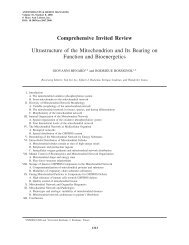MiPsummer Programme pdf - Mitochondrial Physiology Society
MiPsummer Programme pdf - Mitochondrial Physiology Society
MiPsummer Programme pdf - Mitochondrial Physiology Society
You also want an ePaper? Increase the reach of your titles
YUMPU automatically turns print PDFs into web optimized ePapers that Google loves.
73<br />
Abstract # 42<br />
CVB3-induced oxidative stress regulates cell metabolism and innate immune response to infection<br />
via mitochondrial antiviral signaling protein (MAVS)<br />
Andreas Koenig 1 , Iwona A.Buskiewicz 2 , Sally A. Huber 2 and Ralph C. Budd 1<br />
Department of Medicine – Immunobiology 1 , Department of Pathology 2 and Vermont Center for<br />
Immunology and Infectious Diseases, University of Vermont, Burlington, VT 05405, USA<br />
The RNA virus Coxsackie B3 (CVB3) is an important human pathogen, which is one of the leading<br />
causes of severe alimentary tract infection and viral myocarditis. In addition to activating “classical”<br />
innate and adaptive immune responses, CVB 3 infection stimulates other cellular activities such as<br />
production of reactive oxygen species (ROS). There is little knowledge on the cross-talk between ROS<br />
and the innate antiviral response. Our data suggest that CVB3 infection leads to the production of ROS<br />
in T cells, and that ROS plays a critical role in activation of mitochondria associated innate immune<br />
RIG-I pathway. In this pathway the cytosolic RIG-I like helicases recognize the viral RNA and upon<br />
interaction with the mitochondrial antiviral signaling protein (MAVS), recruit signaling molecules that<br />
activate the transcription factors NF-B and IRF-3/7 to promote secretion of type I interferon (IFN). The<br />
exact mechanism and regulation downstream of MAVS-sequestered complex remains unclear but our<br />
preliminary and published data suggest that pro-apoptotic caspase-3 and -9 may regulate signaling of the<br />
RIG-I pathway in MAVS dependent fashion via ROS stimulated glutathionylation, which promotes<br />
redox-sensitive signaling. Furthermore, our data suggest that CVB3 affects cellular metabolism by<br />
depleting MAVS from the mitochondrial membrane, which in turn influences T cell proliferation and<br />
expansion. Our data supports the idea that the innate immune system not only detects specific viral<br />
molecules but also senses the cellular oxidative stress level, and integrates this into the innate immune<br />
response to infections.



